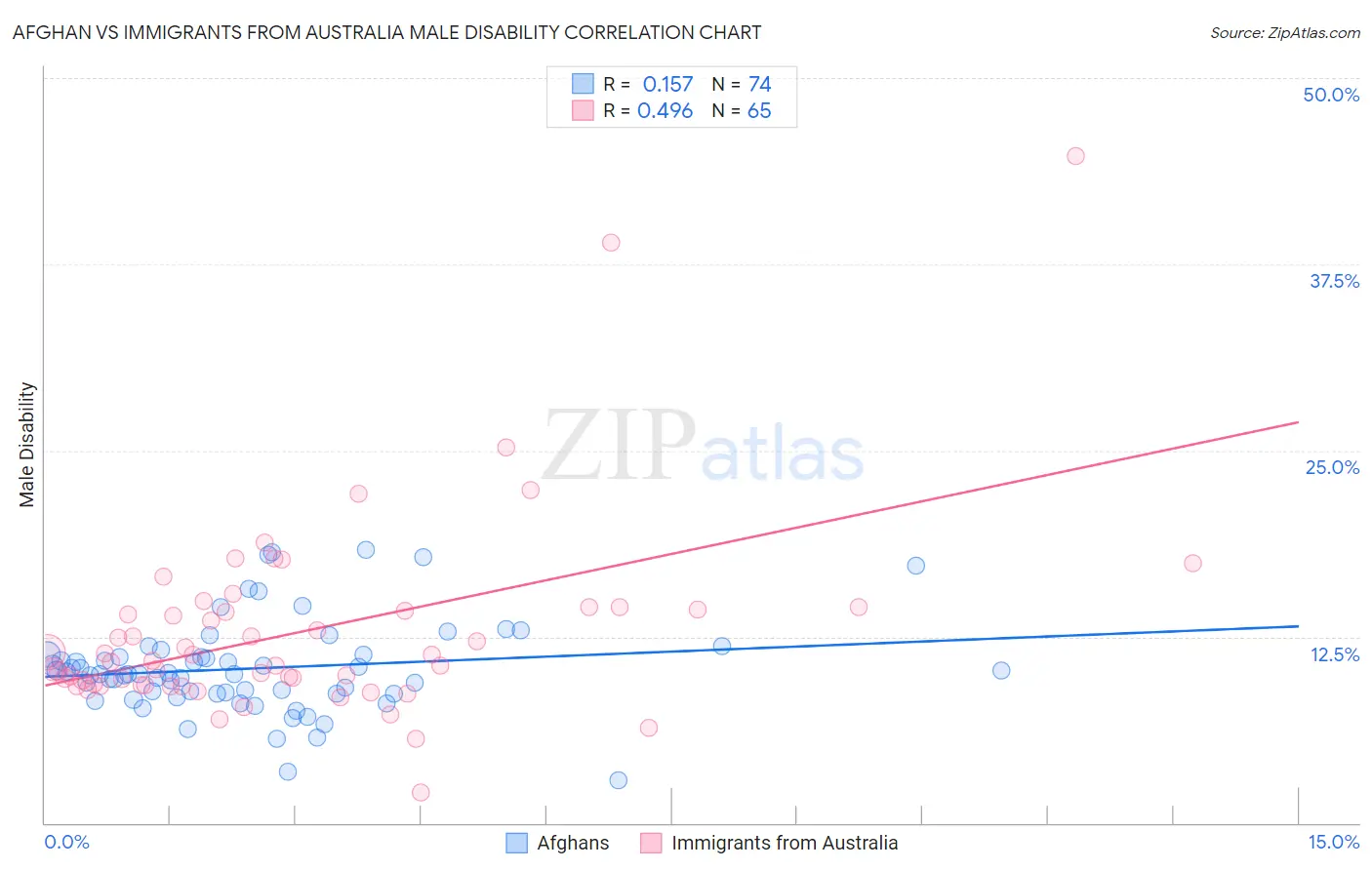Afghan vs Immigrants from Australia Male Disability
COMPARE
Afghan
Immigrants from Australia
Male Disability
Male Disability Comparison
Afghans
Immigrants from Australia
10.2%
MALE DISABILITY
99.8/ 100
METRIC RATING
39th/ 347
METRIC RANK
10.4%
MALE DISABILITY
99.5/ 100
METRIC RATING
59th/ 347
METRIC RANK
Afghan vs Immigrants from Australia Male Disability Correlation Chart
The statistical analysis conducted on geographies consisting of 148,871,579 people shows a poor positive correlation between the proportion of Afghans and percentage of males with a disability in the United States with a correlation coefficient (R) of 0.157 and weighted average of 10.2%. Similarly, the statistical analysis conducted on geographies consisting of 227,204,405 people shows a moderate positive correlation between the proportion of Immigrants from Australia and percentage of males with a disability in the United States with a correlation coefficient (R) of 0.496 and weighted average of 10.4%, a difference of 1.5%.

Male Disability Correlation Summary
| Measurement | Afghan | Immigrants from Australia |
| Minimum | 2.9% | 2.0% |
| Maximum | 18.3% | 44.7% |
| Range | 15.4% | 42.7% |
| Mean | 10.4% | 12.8% |
| Median | 10.0% | 10.9% |
| Interquartile 25% (IQ1) | 8.7% | 9.2% |
| Interquartile 75% (IQ3) | 11.3% | 14.4% |
| Interquartile Range (IQR) | 2.6% | 5.2% |
| Standard Deviation (Sample) | 3.1% | 6.6% |
| Standard Deviation (Population) | 3.0% | 6.6% |
Demographics Similar to Afghans and Immigrants from Australia by Male Disability
In terms of male disability, the demographic groups most similar to Afghans are Immigrants from Nepal (10.3%, a difference of 0.19%), Taiwanese (10.3%, a difference of 0.19%), Mongolian (10.3%, a difference of 0.44%), Immigrants from Bangladesh (10.3%, a difference of 0.47%), and Immigrants from El Salvador (10.3%, a difference of 0.54%). Similarly, the demographic groups most similar to Immigrants from Australia are Immigrants from Japan (10.4%, a difference of 0.14%), Immigrants from South America (10.4%, a difference of 0.22%), Tongan (10.4%, a difference of 0.24%), Immigrants from Eritrea (10.4%, a difference of 0.28%), and Peruvian (10.4%, a difference of 0.30%).
| Demographics | Rating | Rank | Male Disability |
| Afghans | 99.8 /100 | #39 | Exceptional 10.2% |
| Immigrants | Nepal | 99.8 /100 | #40 | Exceptional 10.3% |
| Taiwanese | 99.8 /100 | #41 | Exceptional 10.3% |
| Mongolians | 99.7 /100 | #42 | Exceptional 10.3% |
| Immigrants | Bangladesh | 99.7 /100 | #43 | Exceptional 10.3% |
| Immigrants | El Salvador | 99.7 /100 | #44 | Exceptional 10.3% |
| Turks | 99.7 /100 | #45 | Exceptional 10.3% |
| Cambodians | 99.7 /100 | #46 | Exceptional 10.3% |
| Immigrants | Peru | 99.7 /100 | #47 | Exceptional 10.3% |
| Israelis | 99.7 /100 | #48 | Exceptional 10.3% |
| Immigrants | Spain | 99.7 /100 | #49 | Exceptional 10.3% |
| South Americans | 99.6 /100 | #50 | Exceptional 10.3% |
| Salvadorans | 99.6 /100 | #51 | Exceptional 10.4% |
| Immigrants | Saudi Arabia | 99.6 /100 | #52 | Exceptional 10.4% |
| Immigrants | Uzbekistan | 99.6 /100 | #53 | Exceptional 10.4% |
| Peruvians | 99.6 /100 | #54 | Exceptional 10.4% |
| Immigrants | Eritrea | 99.6 /100 | #55 | Exceptional 10.4% |
| Tongans | 99.6 /100 | #56 | Exceptional 10.4% |
| Immigrants | South America | 99.6 /100 | #57 | Exceptional 10.4% |
| Immigrants | Japan | 99.5 /100 | #58 | Exceptional 10.4% |
| Immigrants | Australia | 99.5 /100 | #59 | Exceptional 10.4% |